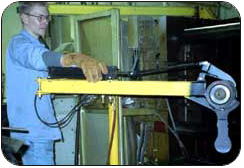Other Headlines
 Die cast copper rotor being removed from the Bühler die casting machine by Jay Keist of Formcast Inc.
Die cast copper rotor being removed from the Bühler die casting machine by Jay Keist of Formcast Inc.Formcast, a technology development company in Denver, Colorado, performed the copper die castings using several candidate mold materials and continues to play a significant role in revealing the key to economical copper rotor die casting. "Copper gives the motor industry another option," explains Dr. Stephen Midson, general manager of Formcast, "…it gives them the option of producing a more efficient or less expensive motor."
Formcast became involved with the copper motor project in its early stages. "Formcast started as a technology development company and that's kind of how we got involved with the project," Dr. Midson explains. "It was a good fit."
The castings of copper rotors at Formcast facilitated the major breakthrough of the copper motor rotor project - increased die life. Molds fabricated from a suitable high-temperature material were preheated to 600°C prior to injecting the copper. This creates less stress throughout the die and closes the gap between the temperatures inside and outside the mold. Based on this extended die life, preliminary calculations show copper rotors will be cost competitive with their aluminum counterparts.
Because die life is such an important influence on the overall cost of the rotors, testing continues in order to get a more definitive measurement of die life and to determine just how much of an advantage the rotors will have. Until that testing is completed, an accurate assessment of potential market penetration cannot be determined.
The project is now in the early phases of production. "Initial runs are positive and have proven commercial feasibility," says Dr. Midson. A handful of companies throughout the world have moved into production of the copper rotor. Their experience, along with continued trials at Formcast, will help to fill in the blanks regarding ultimate market potential.
Meanwhile, Formcast has gained a significant edge in die casting copper. It is presently one of the few technology development companies where copper die casting experiments can be performed. The company has specialized equipment such as an Inductotherm induction-heated furnace that melts copper quickly, limiting oxygen contamination. As a result of its expertise, Formcast has been receiving inquiries from companies who wish to cast copper rotors to their own specifications.
This new die technology is not limited to copper, or to rotors. Research is underway to die cast stainless steel using the process developed through work on the copper motor rotor project. And, there are still numerous copper components other than motor rotors that are potential candidates for the process.
